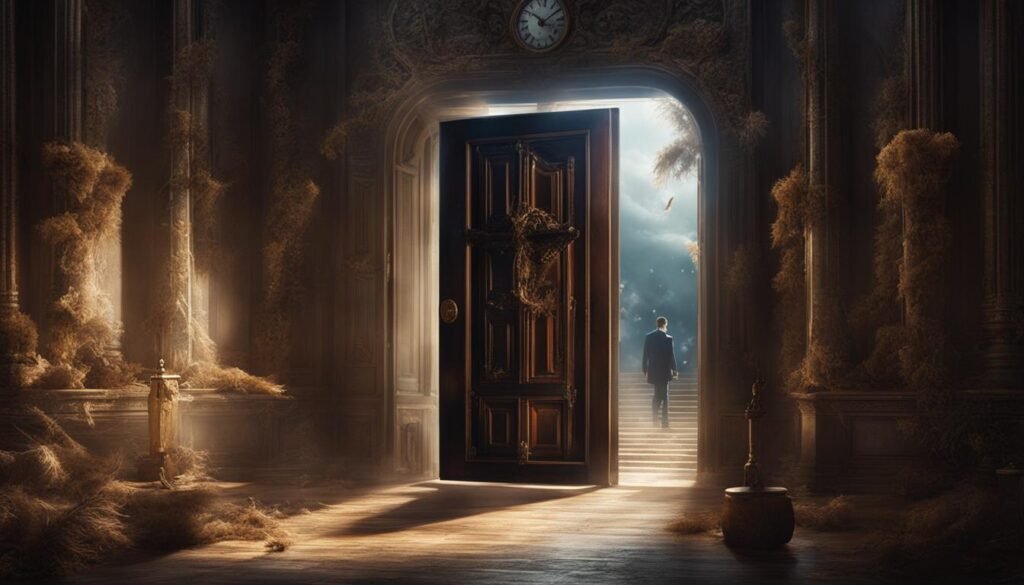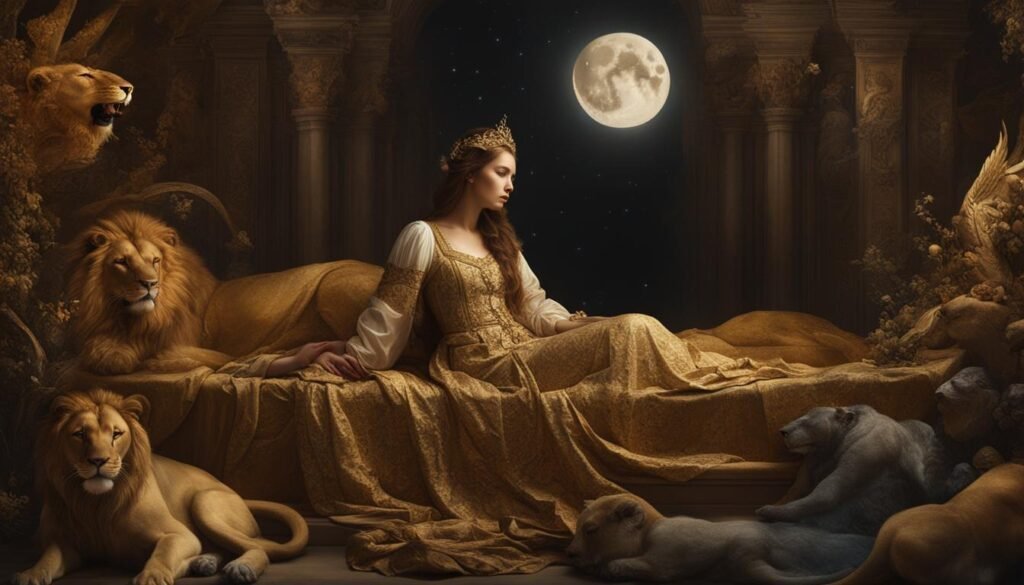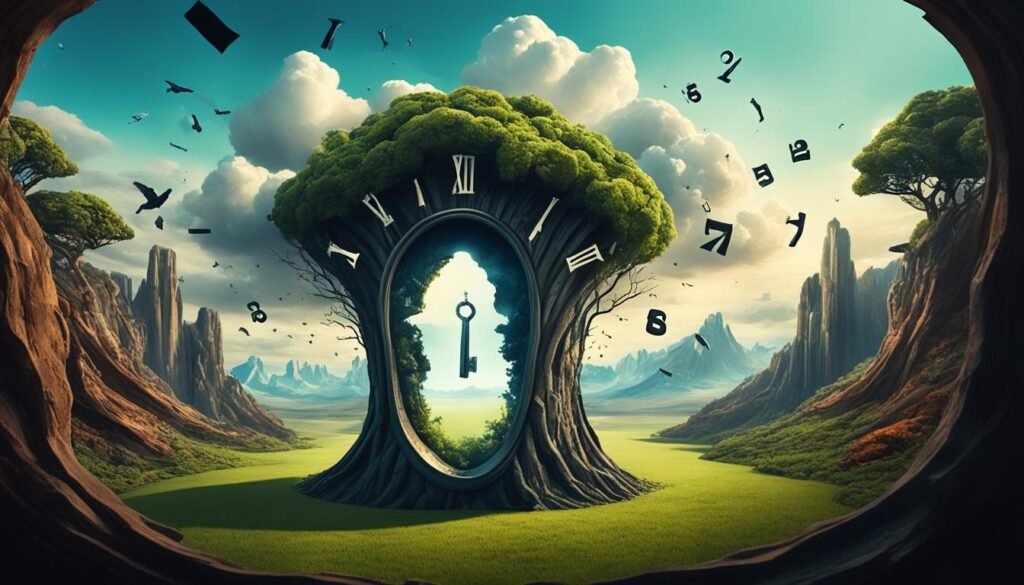Welcome to a fascinating journey into the world of dream symbols in art, where aesthetics and subconscious exploration converge. Art has long been a conduit for understanding our dreams on a deeper level, and by analyzing the symbolism in artworks, we can unlock hidden meanings and gain profound insights into our inner thoughts and emotions.
Artists have harnessed the power of symbols to represent elements of dreams and the subconscious mind. Through their use of symbolic imagery, they invite us to interpret and decode the messages conveyed. This exploration of dream symbols in art allows us to unravel the mysteries of our dreams and tap into the universal themes they encompass.
By delving into the meaning and interpretation of dream symbols in art, we can cultivate a better understanding of ourselves and our dreams. Are you ready to embark on this artistic journey, where dreams and art intertwine to reveal profound aesthetic insights? Let’s dive in!
Key Takeaways:
- Dream symbols in art provide a pathway to explore the subconscious mind and gain aesthetic insights.
- Analyzing the symbolism in artworks helps decode hidden meanings behind our dreams.
- Artists use symbolic imagery to represent elements of dreams and the universal themes they embody.
- Interpreting dream symbols in art enhances our understanding of ourselves and the world around us.
- Exploring dream symbols in art is a transformative journey of self-discovery and personal growth.
The Power of Dream Symbols in Art
Symbols in art possess a remarkable ability to convey intricate ideas and evoke profound emotions. Many artists utilize symbolic imagery to represent elements derived from dreams and the depths of the subconscious mind. By closely analyzing these symbols incorporated into artworks, we gain a profound understanding of our own dreams and the universal themes they represent.
Artists employ symbolism in their work as a means to communicate concepts that transcend mere visual representation. Symbolic imagery allows us to access the hidden realms of our imagination, exploring dreamlike landscapes and narratives that tap into the collective unconscious. By engaging with artistic representations of dreams, we unlock the potential for personal reflection and self-discovery, as we decode the intricate web of symbolism within.
When examining dream symbols in artwork, one can uncover profound insights into the human experience. Symbolism in art offers a unique language through which artists communicate their interpretation of dreams, often conveying complex ideas and emotions that words alone cannot capture. Analyzing dream symbols in art enables us to explore the collective unconscious, connecting with universal themes and experiencing a deeper understanding of our own dreams.
“Art is the lie that enables us to realize the truth.” – Pablo Picasso
Symbolic representation allows artists not only to express their own thoughts and emotions but also to invite viewers into an immersive experience. As we engage with artworks that incorporate dream symbols, we embark on an interpretive journey, diving into the depths of our subconscious mind. This exploration not only enhances our aesthetic appreciation but also empowers us to decipher the profound meanings embedded within the intricate tapestry of dream-inspired art.
The Universal Language of Symbols
- Symbols hold a rich cultural significance, transcending language barriers and speaking directly to our primal instincts.
- Artists use symbols to communicate complex ideas and emotions, creating a visual language that resonates with viewers on a deep level.
- Symbolic imagery in art can provide a bridge between the conscious and unconscious mind, guiding us through a labyrinth of meanings and interpretations.
Unveiling Meaning Through Art
Art has always served as a powerful tool for understanding and exploring the intricate world of dreams. By delving into the visual elements and symbolism in artworks inspired by dreams, we can embark on a journey to uncover the hidden meanings and messages behind our subconscious desires.
When analyzing dream symbols in art, we are given a unique opportunity to decipher the secrets that our dreams hold. The visual representations captured by artists provide a window into the depths of our unconscious mind and offer insights into our innermost thoughts, fears, and desires.
Art acts as a bridge, connecting the realms of dreams and consciousness. It allows us to interpret the symbolic language of our dreams and explore their profound significance. By immersing ourselves in the world of dream-inspired art, we gain a deeper understanding of ourselves and the human experience.
Art has the ability to evoke emotions and provoke thought, enabling us to interpret the meaning behind dream symbols and unlock the doors to our own subconscious.
The use of imagery and symbolism in dream-inspired artworks further enriches our understanding of dreams. Through careful observation, analysis, and interpretation, we can unravel the hidden messages from our unconscious mind. The power of art lies in its ability to convey these messages through visual representations, creating a visceral experience that resonates with our innermost selves.
Art provides a medium through which we can explore the depths of our dreams, peering into the mysterious realm of the subconscious and unraveling the profound meanings and messages they hold.
As we engage with dream-inspired art, we find ourselves on a transformative journey of self-discovery. It is through this exploration that we gain a deeper understanding of our dreams, the symbolism they contain, and their impact on our waking lives.
Art, with its ability to transcend words and language, offers us a powerful tool for understanding and unraveling the mysteries of our dreams. By delving into dream symbols in art, we gain insights into our subconscious desires, fears, and aspirations, ultimately leading us to a greater understanding of ourselves.
Art, as a tool for understanding dreams, allows us to embark on a personal and introspective journey, unlocking the profound meanings hidden within the realm of our dreams.
The Journey of Interpretation
Decoding dream symbols in art is an intricate process that takes you on a journey of interpretation. Artists often incorporate symbolic imagery in their dream-inspired art, allowing viewers to delve into the hidden meanings behind these symbols. By closely examining the context, composition, and use of symbols in the artwork, you can gain valuable insights into the artist’s interpretation of dream symbols and apply these insights to your own understanding of dreams.
As you embark on this journey, pay attention to the visual cues within the artwork. Look for recurring symbols or motifs that may carry specific meanings. Consider how these symbols interact with one another and the overall composition of the piece. Remember, dream symbols in art are not always literal representations but rather metaphorical or abstract expressions.
Interpretation is subjective, and each viewer may have a unique understanding of the symbols presented. Trust your intuition and personal associations when deciphering the meaning behind dream-inspired art. Engage in an active dialogue with the artwork, allowing your own thoughts, emotions, and experiences to shape your interpretation.
The process of decoding dream symbols in art is an opportunity for self-reflection and introspection. It encourages you to explore your own subconscious thoughts, desires, and fears. The rich symbolism found in dream-inspired art invites you to connect with your innermost self and gain a deeper understanding of your own dreams and aspirations.


Symbolic dreams can be transformative and enlightening, offering insights into our innermost thoughts and desires. They serve as powerful sources of inspiration for artists, who harness the symbolic elements of dreams to create thought-provoking artworks that capture the essence of the subconscious.
By exploring real-life dream stories, we can delve into the realm of symbolism and gain a deeper appreciation for the intricacies of the human psyche. These stories not only provide artistic inspiration but also serve as a means of self-reflection and personal growth.
The Power of Symbolic Dreams
- Symbolic dreams communicate deeply rooted emotions and desires.
- They offer a glimpse into the subconscious mind.
- Symbolic dreams often contain recurring motifs and imagery.
- They have a profound impact on personal growth and self-discovery.
- Symbolic dreams can inspire creativity and artistic expression.
The exploration of real-life dream stories allows us to uncover the hidden meanings behind the symbolism and gain a richer understanding of the human experience. Whether fantastical or mundane, symbolic dreams offer a unique lens through which we can explore our innermost thoughts, desires, and fears.
Historical Depictions of Dreams
Throughout history, artists have captured the ethereal realm of dreams in their artworks. During the Renaissance period, dreams were often portrayed as transcendent experiences, with religious themes and biblical stories serving as popular subjects. Masters like Raphael and Albrecht Dürer skillfully depicted the symbolic and spiritual aspects of dreams in their art.
In Renaissance art, dreams were often seen as a means of divine communication, conveying messages from heavenly realms. Artists drew inspiration from biblical narratives and infused their works with rich symbolism, creating a visual language that conveyed the profoundness of dream experiences.
For example, Raphael, renowned for his frescoes in the Vatican, incorporated dream symbolism in his masterpiece “The Marriage of the Virgin.” In this work, the dream of the high priest serves as a pivotal moment, emphasizing the sacredness and significance of the union depicted.
Albrecht Dürer, a prominent German artist of the time, also delved into dream imagery in his woodcuts and engravings. In his renowned work “The Witch and Death,” he employed dream-like symbolism to explore themes of mortality and temptation.
These historical depictions of dreams in Renaissance art provide us with valuable insights into the cultural significance and interpretation of dream symbols. They show us how dreams have been perceived and portrayed throughout different time periods and remind us of the enduring human fascination with the enigmatic world of dreams.


The Symbolic Language of Dreams in Art
- Dreams as divine messages: Renaissance artists often depicted dreams as vehicles for divine communication, using dream imagery to convey spiritual and religious themes.
- Visual symbolism: Artists incorporated symbolic elements into their works to represent the hidden meanings and messages behind dream experiences.
- Exploration of the subconscious: Dream-inspired art allowed artists to tap into the depths of the human psyche, exploring the realms of imagination and the unconscious mind.
- Cultural context: Renaissance artworks reflected the religious and cultural beliefs of the time and offered insights into how dreams were perceived in society.
Surrealist Exploration of Dreams
Surrealist artists have long been fascinated by the mysterious and captivating realm of dreams. One of the most prominent figures in surrealism is Salvador Dali, whose dream-inspired art captivated audiences with its fantastical and otherworldly imagery.
evoke a sense of wonder and fascination. Through his use of dream symbols and bizarre imagery, Dali invites viewers to explore the depths of the subconscious mind.
Inspired by his own dreams and the works of Sigmund Freud, Dali believed that dreams held profound meaning and were windows into the unconscious. By embracing dream symbols and allowing his unconscious mind to guide his artistic process, Dali created thought-provoking artworks that challenge our perceptions of reality.
Dali’s surrealistic exploration of dreams paved the way for a new artistic movement that revolutionized the art world. Surrealism allowed artists to break free from traditional artistic constraints and explore the boundless possibilities of the dream world.
Through their dream-inspired art, surrealists like Dali aimed to express the enigmatic and irrational nature of dreams. By delving into the depths of the subconscious, these artists created captivating and thought-provoking artworks that continue to inspire and intrigue audiences to this day.
Dreams as a Source of Inspiration
Dreams have always been a powerful source of inspiration for artists throughout history. The ethereal and enigmatic qualities of dreams have captivated creative minds, leading to the creation of mesmerizing artworks that evoke wonder, mystery, and imagination.
When artists delve into their dreamscapes, they extract rich imagery and symbolism that permeates their work, giving it a dream-like quality. These elements serve as a visual language, enabling artists to express their innermost thoughts, emotions, and experiences.
The Wonder of Dream-like Qualities
The dream-like qualities in art transport viewers to a realm beyond the ordinary, blurring the line between reality and the subconscious. Through dream-inspired compositions, artists recreate the surreal and fantastical nature of dreams, inviting us to embark on a journey of limitless possibilities.
The dream-like qualities in art have the power to awaken dormant emotions, stir deep introspection, and ignite the imagination. They invite us to explore the unknown and challenge conventional perceptions, offering a unique glimpse into the mysteries of the human psyche.
A World of Symbolism and Imagery
Within the realm of dreams lies a treasure trove of symbolism and imagery. Artists tap into this wealth of inspiration, transforming their visions into poignant visual narratives that resonate with viewers on a profound level.
Just as dreams can be filled with complex symbols and metaphors, artists infuse their creations with these symbolic elements. These symbols may carry personal significance to the artist or evoke universal archetypes that speak to the shared human experience.
The use of dream symbols in art adds depth and layers of meaning, inviting viewers to decipher and interpret the hidden messages embedded within the artwork. This engagement with the symbolism fosters an intimate connection between the artist, the artwork, and the viewer.
Appreciating the Depth of Artistic Expression
By delving into the influence of dreams on art, we gain a greater appreciation for the depth and richness of artistic expression. The merging of the conscious and unconscious mind gives birth to extraordinary artistic creations that transcend the limitations of reality.
Exploring the dream-like qualities in art allows us to enter a world where imagination knows no boundaries and where possibilities are endless. It invites us to embrace the beauty of the unknown, to find inspiration in our own dreams, and to celebrate the transformative power of artistic expression.
The Impact of Dreams on Personal Growth
Exploring dream symbols in art can have a profound impact on personal growth and self-discovery. By delving into the meanings and messages behind dream symbols, you can gain valuable insights into your own subconscious thoughts and emotions. This process of self-reflection and exploration can lead to personal growth, increased self-awareness, and a deeper understanding of your own dreams.
Dream exploration through art allows you to tap into the depths of your mind, uncovering hidden meanings and deciphering the language of your subconscious. It provides a unique opportunity to connect with your dreams on a visual and emotional level. As you analyze and interpret dream symbols in art, you gain a better understanding of yourself, your desires, fears, and aspirations.
Through art, you can visually express and explore the complex layers of your dreams. Symbols in art can act as a bridge between your conscious and unconscious mind, allowing you to delve deeper into the realms of your psyche. The creative process of interpreting dream symbols in art encourages introspection, reflection, and self-discovery.
By engaging with dream symbols in art, you embark on a journey of personal growth and transformation. The exploration of your dreams through art provides an opportunity for self-reflection, healing, and understanding. It enables you to develop a stronger connection with your subconscious and discover hidden aspects of yourself.
As you delve deeper into the world of dream symbols in art, you unlock new layers of self-awareness and gain a fresh perspective on your own dreams. This process of self-discovery empowers you to make positive changes in your life, embrace your true desires, and overcome obstacles that may be holding you back.
Exploring dream symbols in art not only allows you to understand yourself better but also fosters personal growth and development. As you analyze and interpret dream symbols, you cultivate a deeper understanding of your own emotions, motivations, and aspirations. This newfound self-awareness serves as a foundation for personal growth and guides you on a path of self-improvement.
In conclusion, the impact of exploring dream symbols in art goes beyond aesthetic appreciation. It offers a transformative journey of self-discovery, personal growth, and increased self-awareness. By delving into the rich symbolism of dreams through art, you can unearth the hidden depths of your subconscious and embark on a path of personal empowerment.
Conclusion
By exploring dream symbols in art, you open yourself up to a world of exploration and self-discovery. The symbolism found in artworks allows you to delve deeper into your subconscious mind and uncover hidden meanings and messages. Whether it’s deciphering the enigmatic surrealism of Salvador Dali or analyzing the historical depictions of dreams in Renaissance art, the world of dream symbols in art provides an endless source of aesthetic insights.
Understanding dream symbols in art goes beyond mere interpretation; it allows you to connect with your own dreams on a profound level. Through the use of visual imagery and symbolism, artists capture the essence of the dream world and bring it to life on canvas. By studying these artworks, you gain a richer understanding of the symbolism present in your own dreams and the universal themes they represent.
Art has the power to transform and inspire, and by delving into dream symbols in art, you tap into this transformative power. As you explore the depths of your own dreams, you embark on a journey of self-discovery and personal growth. The exploration of dream symbols in art not only enhances your understanding of dreams but also offers a unique way to appreciate the beauty and complexity of artistic expression.
Can Dream Symbols in Art Provide Insights into Decoding Dream Symbolism?
Art can be a powerful tool for decoding symbolism in dreams. Dream symbols in art can provide valuable insights into the subconscious mind. By examining how artists represent dream imagery, we can gain a deeper understanding of the universal themes and meanings behind decoding symbolism in dreams.

